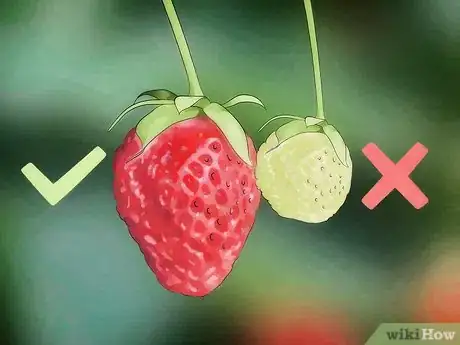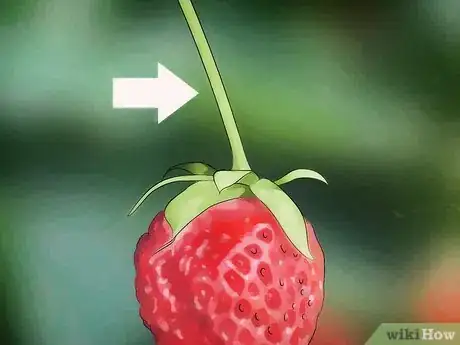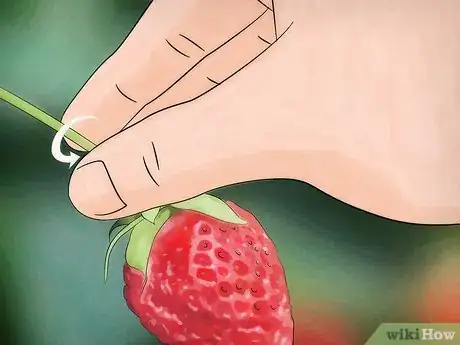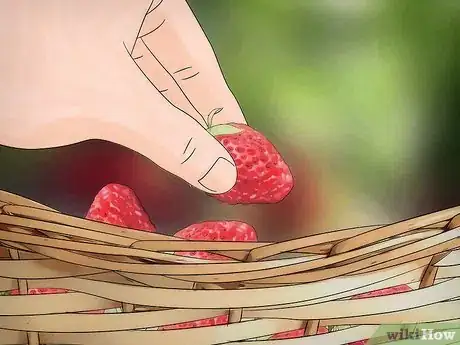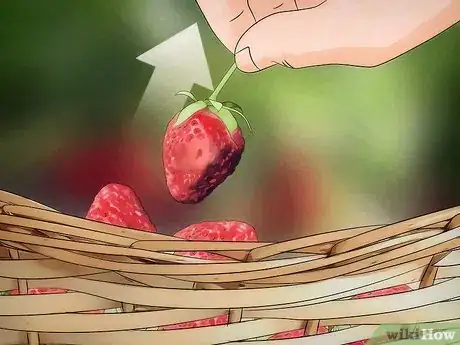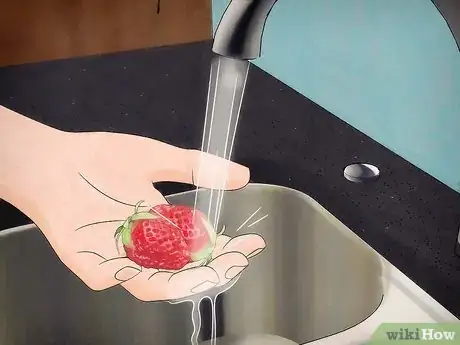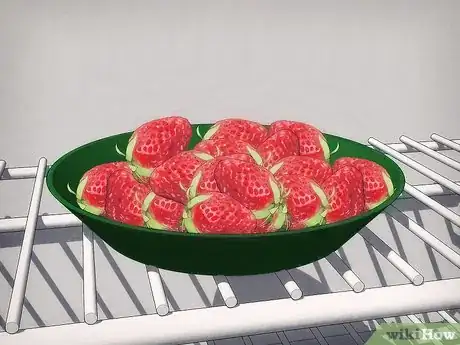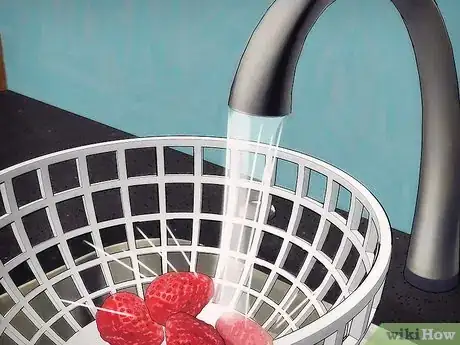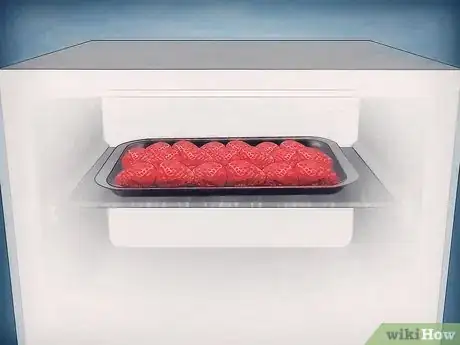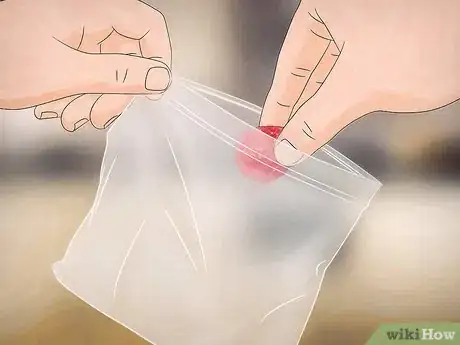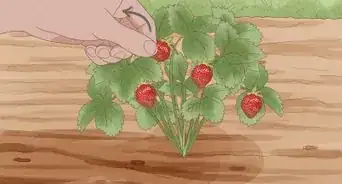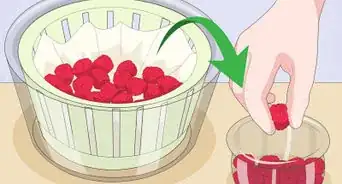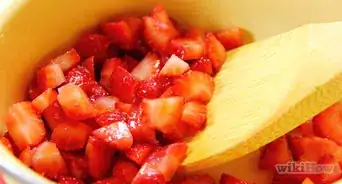This article was co-authored by wikiHow Staff. Our trained team of editors and researchers validate articles for accuracy and comprehensiveness. wikiHow's Content Management Team carefully monitors the work from our editorial staff to ensure that each article is backed by trusted research and meets our high quality standards.
There are 7 references cited in this article, which can be found at the bottom of the page.
This article has been viewed 58,225 times.
Learn more...
At the height of their season, there's nothing like delicious, fresh strawberries -- and picking them is an activity that can be fun for the entire family. If you've never gone strawberry picking before, it's not difficult to pick up. You just need to know how to identify the best berries and the best way to care for them once they're picked.
Steps
Picking Strawberries
-
1Have your containers ready. When you pull the strawberries off their plant, you need some type of container to put them, so they don’t get damaged. If you’re at a you-pick farm, they will probably have containers that you can use. However, they usually charge for them, so you may want to bring your own. You don’t want a container that’s too deep because you shouldn’t pile the berries more than 5-inches deep or you may bruise the ones on the bottom.[1]
- Lightweight containers work best because you’ll have to carry them with you as you pick. Tupperware, metal oven pans, and plastic dishpans with sides that are at least 3-inches tall work well. Wicker baskets are a good option too.
- Because you may need to sit or kneel on the ground to pick the berries, you may also want to bring knee pads or a garden cushion to make it more comfortable.
-
2Look for red berries. When you’re trying to decide which strawberries to pick, it’s important to choose ones that are fully red. Strawberries don’t continue to ripen after they’re picked, so they should look like you’d want to eat them when you pick them. In particular, look at the tip of the strawberry -- if it’s red, you can pick it. Avoid berries with white, yellow, or greenish tips.[2]
- Make sure that the strawberries that you pick are plump and feel firm when you touch them too.
Advertisement -
3Grab the berry stem. When you’re ready to pick a strawberry, take hold of its stem approximately 1-inch above the berry between your index finger and thumbnail. Cradle the fruit against your palm without squeezing to avoid bruising the berry.[3]
- Some varieties of strawberries, such as Surecrop berries, are easier to pick than others because they easily snap off the stem when they're mature so you don't have to worry too much about handling them very carefully. However, it's best to handle all berries gently in case you don't know what type they are.
-
4Twist the berry at the stem. The best way to ensure that you don't damage the berries you're picking is to sever them from the plant at the stem. Gently twist it between your fingers to and pull lightly. Allow the strawberry roll down into your palm, and continue the process until your hand is full -- that usually means 3 or 4 berries. Carefully set the berries down in your container, and repeat until you have enough fruit.[4]
- Be careful not to step or kneel on the strawberries or plants as you’re picking.
- If you come across strawberries that are rotten, riddled with insects, burned by sun, or otherwise damaged, remove them from the plant. At home, you can simply throw them away. At a you-pick farm, you’ll usually be directed to leave the damaged berries in the center of the row for collection.
- If possible, don’t leave your containers of picked berries out in the sun. Find a shady spot to keep them so they’ll stay fresh.
- Try to drive home carefully so the strawberries aren’t jostled too much. That will keep them from getting bruised.
Finding Strawberries to Pick
-
1Grow your own. If you enjoy eating strawberries regularly, planting your own may be the best option. That way, you’ll always have your own batch to pick each season. There are varieties that will grow in just about every climate, so you can probably Grow Strawberries wherever you live. It’s often best to start with bare-roots plant rather than seeds to increase your chances for plentiful, healthy berries.[5]
- In most climates, strawberries should be planted in early spring. However, if you live in a mild climate, you can also plant in the fall.
- If you live in an area with cold winters, make sure to mulch your strawberry plants to protect them from frost and other winter damage. You can lay straw loosely over the plants to keep them safe in the cold weather.
- Strawberry plants are subject to a variety of pests and diseases, such strawberry root weevils, mites, and verticillium wilt. Make sure to purchase plants that are certified disease-free and remove any diseased portions or rotten fruit to reduce the chance of problems.
- You’ll need to replace your strawberry plants when you begin to notice signs of decline. Typically, the plants will last approximately three years.
-
2Visit a farm. If you don’t have a green thumb, you can still enjoy picking strawberries -- just find a local farm where you’re allowed to pick your own. Usually, these farms have large fields of strawberries, so you have an even better chance of finding plenty of high quality fruit than you would with a couple of plants in your yard. Berries from a you-pick farm are also healthier than store-bought berries because they usually don’t have as much pesticide and fungicide residue.[6]
- You-pick farms typically sell strawberries by the pound.
- In many cases, the farms might also have other in-season fruit that you can pick, such as raspberries and blueberries, so you can pick a good variety of fruit during your trip.
- If you’re not sure where to find a you-pick farm in your area, do an online search to locate the nearest option.
-
3Get the timing and weather right. Strawberries are typically available for harvesting during the months of April, May, and June, depending on where you live. The warmer your location, the earlier that the berries are usually ripe. Weather, such as rain and cool temperatures, can have a serious effect production, though, so if you’re going to pick at a farm, call beforehand to ensure that there is a supply available.[7]
- If you’re going to a you-pick farm on a weekend, it’s best to leave early. In many cases, the fields will be picked clean by mid-day.
- Keep in mind that strawberries picked on hot, sunny days are likely going to spoil more quickly than those picked on cool days. If you’re not going to use the strawberries that you pick right away, it’s best to pick them in cooler part of the morning or on a cool, overcast day.
- It takes approximately 10 to 15 minutes to pick a quart of strawberries, so make sure you give yourself enough time to pick as many as you need.
Caring for Picked Strawberries at Home
-
1Remove any damaged berries. No matter how discerning you are when you’re picking or how careful you are with them afterward, you may wind up with some rotten or damaged berries when you get home. Carefully pour the fruit into shallow pans and sort through it so you can remove any that show obvious signs of damage.[8]
- Rotten strawberries should be thrown away, while you can toss or eat those that were squashed in transit.
-
2Wash the strawberries just before use. While you should wash your strawberries before you eat or bake with them, it’s important not to do it until you’re ready to use them. That’s because washing the berries makes them spoil more quickly. Run them quickly under cold water to get them clean.[9]
- Don’t allow the berries to soak or sit in the water when you’re washing. That will make them mushy and more prone to mold.
Storing Strawberries
-
1Store in the refrigerator. Strawberries will mold quickly if they’re left at room temperature. The best temperature for preserving them is between 32 and 36 degree Fahrenheit, which is why you should keep them in the refrigerator. Store them in a shallow container, and place them in your crisper drawer if possible.[10]
- In the refrigerator, strawberries will last about a week, depending on how ripe they were when you picked them. It’s usually best to eat them within a few days of picking, though.
- If you have a glut of strawberries, one great way to store extras is to dry them; dried strawberries make great snacks and can be used for baking, cereal mixes and desserts. See How to Dry Strawberries for details on dehydrating strawberries for prolonged storage.
-
2Prep some berries for freezing. If you’ve picked more berries than you can eat within a few days of picking, you’ll want to freeze the excess so they don’t spoil before you can use them. Use a knife to cut away the green, lefty cap at the top of the berries. Next, put them in a colander and wash them in cold water.[11]
- Allow the berries to dry for at least 10 minutes to get rid of any excess water before freezing.
-
3Do the initial freeze on a cookie sheet. Place your clean berries on a cookie sheet or baking pan that's been lined with wax paper. Make sure that they're in a single layer, so none of the berries stick to one another as they freeze. Allow them to sit in the freezer until they're completely solid.[12]
- You can slice the berries before placing them on the cookie sheet if you prefer.
-
4Place the frozen berries in freezer bags. Once the berries have undergone their initial freeze, you can transfer them to plastic freezer bags. It's important to take the time to squeeze out as much air as possible from the bags to prevent freezer burn. After they berries are packaged, try to place them on the coldest shelf in your freezer.[13]
- If you have a vacuum sealer system, it’s a good idea to use it on the freezer bags of strawberries before they go in the freezer.
- If you don’t have a vacuum sealer, close the freezer bags almost all the way, leaving just enough room for a straw. Suck all the air out of the bag through the straw, and pinch the straw closed. Pull it out, and quickly close the bag to keep it as air-tight as possible.
- Write the date on the freezer bag before you put the strawberries in the freezer so you’ll always know how old they are.
- Strawberries will last for approximately 6 months in the freezer.
Community Q&A
-
QuestionDo I cut off the stem off the berry?
 DonaganTop AnswererA strawberry stays fresh longer if the stem is still attached. Pull it off just before serving.
DonaganTop AnswererA strawberry stays fresh longer if the stem is still attached. Pull it off just before serving.
References
- ↑ https://www.pickyourown.org/strawberries.htm
- ↑ http://strawberryplants.org/2010/06/strawberry-picking/
- ↑ http://www.aces.uiuc.edu/vista/html_pubs/STRWBRY/berry.html
- ↑ http://www.aces.uiuc.edu/vista/html_pubs/STRWBRY/berry.html
- ↑ http://www.sunset.com/garden/fruits-veggies/strawberries
- ↑ https://www.pickyourown.org/strawberries.htm
- ↑ https://www.pickyourown.org/strawberries.htm
- ↑ http://strawberryplants.org/2010/06/strawberry-picking/
- ↑ http://strawberryplants.org/2010/06/strawberry-picking/
- ↑ http://strawberryplants.org/2013/02/how-to-store-strawberries/
- ↑ https://www.pickyourown.org/strawberries_freezing.htm#8dY28GxBj1oW0U8z.97
- ↑ https://www.thekitchn.com/the-best-ways-to-store-strawberries-tips-from-the-kitchn-219932
- ↑ https://www.pickyourown.org/strawberries_freezing.htm#8dY28GxBj1oW0U8z.97
About This Article
To pick strawberries, look for ones that are fully red since strawberries don't continue to ripen after they're picked. Avoid picking strawberries with white, yellow, or green tips since they're not ripe enough. Also, feel strawberries before picking them to make sure they're firm and plump, which is a sign that they're ripe. Once you've found a strawberry that you want to pick, grab the stem about 1 inch above the fruit. Then, twist and pull lightly to release the strawberry from the plant. To learn how to care for picked strawberries once you get home, scroll down!

